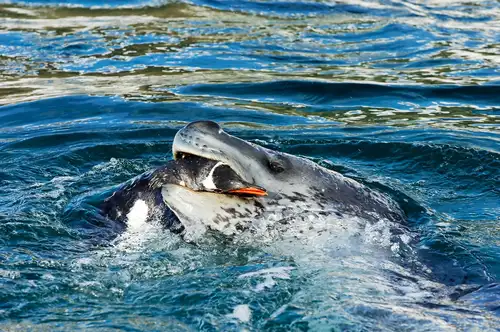Name: Weddell Seal (Leptonychotes weddellii)
Length: 2.5 to 3.5 metres.
Weight: 400 to 600kg.
Location: Antarctica.
Conservation status: Least Concern.
Diet: Fish, crustaceans, krill, squid, prawns, cephalopods, penguins, other seals.
Appearance: Brown or dark silver with lighter-coloured dappling on the belly.
How do Weddell Seals feed?
Weddell Seals can stay submerged for up to 80 minutes, diving over 600 metres deep. They have more red blood cells and blood volume than other mammals, allowing them to carry more oxygen. Their excellent underwater vision helps them spot fish silhouetted against the ice. In dark winters, they use their sensitive vibrissae (whiskers) to detect prey.

Are Weddell Seals social?
Weddell Seals gather around breathing holes in the ice and stay together in the water during Antarctic winters, with just their noses poking out to avoid harsh winds.
How fast do Weddell Seals swim?
Weddell Seals swim at around 10km per hour.
What are Weddell Seal mating rituals like?
Females mature sexually at around 3 years, but both sexes usually wait until about 7. Birthing season is from early September to November. Mating is noisy and occurs underwater, with males often biting the female's neck. Birth is quick, usually under 5 minutes, and they can give birth to twins. Pups are about 1.25 metres and 25kg at birth, gaining around 2kg daily from their mother's milk. By 7 weeks, pups can weigh around 100kg. Mothers do not feed during this period, growing thin as the pups grow plumper. Pups start swimming between 1 and 2 weeks old, diving for 5 minutes and reaching depths of 100 metres. Weaning occurs at about 6 weeks, when they begin hunting on their own.

How long do Weddell Seals live?
Weddell Seals live an average of 30 years.
How many Weddell Seals are there today?
There are over 800,000 Weddell Seals worldwide.
Do Weddell Seals have any natural predators?
Killer Whales and Leopard Seals prey on Weddell Seals, with Leopard Seals usually targeting the young.
6 Wonderful Weddell Seal Facts
- Weddell Seals live the furthest south of any mammals.
- They are the most studied Seal species in the Antarctic.
- Named after James Weddell, a British sealing vessel captain.
- Females are generally longer and heavier than males.
- They have a membrane over their eyes to protect from snow and salt.
- Nothing is known about their hearing ability.

Bouvet Island: The Most Remote Island in the World

The Wildlife of Antarctica’s Seas and Skies

The secrets of Antarctic seals revealed

11 Seals You May See in Antarctica or the Arctic

The Ways and Wildlife of the Weddell Sea

The Classic Polar Cruise: Antarctic Peninsula Facts, Pics, and More






